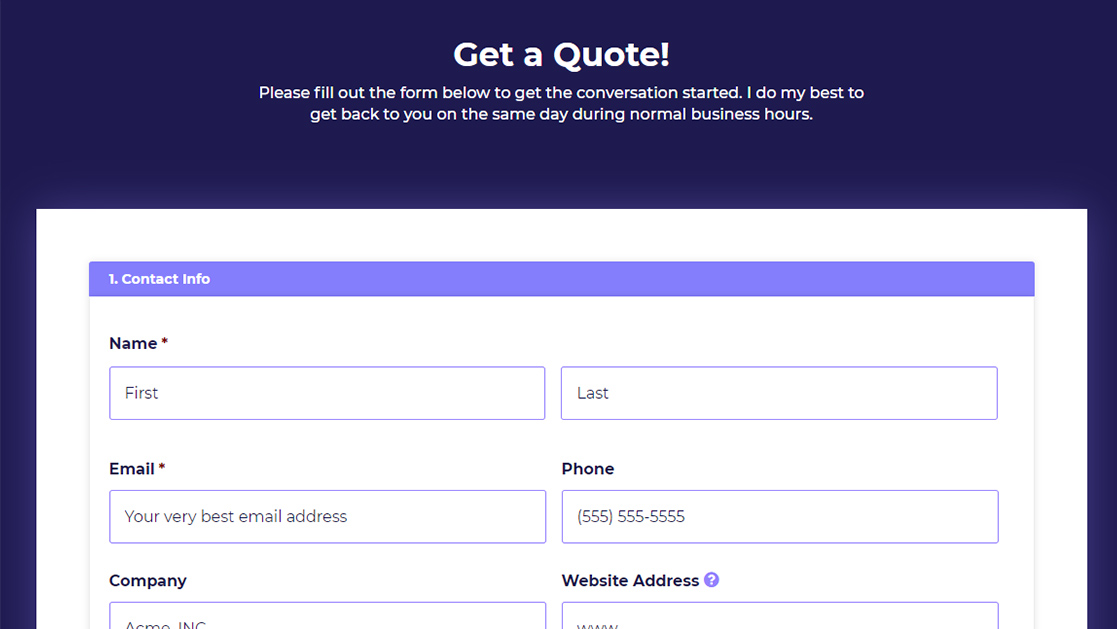Often times, I hear business owners complain about their website not doing anything for them in terms of generating sales. In fact, a lot of people think they are wasting their valuable time and money on their website because they never see any return on their investment. If this sounds like you, or if you don’t even have a website for your business, I’d like you to stick around to learn how easy it is to generate leads from your website!
What is a lead?
A lead is simply someone interested in purchasing your company’s product or service. These are people coming to your website and filling out forms to contact you, dialing your phone number (which they found on your website), or showing any other intent to buy.
Here’s an example of a lead generated on my website:

This is a person who could potentially buy a website from me. A qualified lead is a person who has a need in their near future for your product or service and they have the financial means to make a purchase. Like Ben in the example above, your qualified lead should be interested in opening up a conversation with you or someone on your sales team.
How do I generate leads?
Your leads come from your website. Everything starts with your website. It’s the central hub for all of your online marketing campaigns, and without it, it would be very difficult to find prospective customers online.
Here is the basic flow of how a conversion focused website generates leads:

Your digital marketing campaigns should drive quality traffic to your website. It’s your website’s job to turn those site visitors into leads. This is called “converting” a visitor. A website converts a visitor (stranger) into a lead by getting that visitor to provide you with their name and contact information.
Your Website has a “Conversion Rate”
Your conversion rate is simply the total number of leads generated from your website divided by the number of visitors to your website over a period of time.
For example, if your website generates 2 leads for your business in one week and you had a total of 100 visitors, your conversion rate would be 2% (2 leads / 100 visitors = 0.02).
When planning your lead generation strategy, you can set a goal for the number of leads that you want to be generated for a certain period of time (it’s usually one month). Then you can run your lead generation campaigns and optimize them to help your website reach your goal.
When you know your conversion rate, online lead generation becomes a simple mathematical equation:

This is basically how online lead generation works! What you may notice is the opportunity to influence the first two variables in this equation. You can either (1) increase traffic, or (2) improve your conversion rate.
This is how I teach all of my clients to view online lead generation. A simple math formula with variables that can be influenced through your digital marketing campaigns.
With that in mind, there are two questions that you should be asking your marketing consultant or marketing agency:
- How will you increase quality traffic to my website?
- How will you improve my website’s conversion rate?
As insightful business owners we know we can increase traffic to our website to get more leads:

Simple logic, right? Just drive more traffic into your website to get more leads. It’s important to note, this needs to be quality, relevant traffic.
The other option here is to increase the website’s conversion rate to get more leads:

Again, simple, right? Make your website work better and convert at a higher rate to get more leads. There are a number of ways to increase your conversion rate, which I’ll explain later in this post.
Of course, what we really should do is increase both. Let’s crank up our lead generating machine (that would be your website) by increasing traffic and improving your conversion rate:

Fantastic! Now you can see how manipulating the numbers in our equation can turn your website into a lead generating machine!
Now, I’d like to address the elephant in the room. The big question of the day. “How do I go about increasing my website traffic and improving my website’s conversion rate?”
Let’s find out!
How do I increase my website’s traffic?
You can increase your website’s traffic through traffic driving strategies. These strategies include:
- Blogging – Writing blog posts that feature your target keywords is a great way to help your website rank in search engines for those keywords. These posts are also great for sharing on social media and sending out via email, all of which can drive more traffic to your website. Search engines like Google love websites that are frequently updated with fresh content and they will show them more frequently online.
- Search Engine Optimization (SEO) – Your website’s content should be organized so that it’s easy for search engines like Google to understand. This includes a lot of technical, jargon-filled things like properly structuring your website’s content with header tags, setting up 301 redirects, optimizing meta descriptions and page titles, and fixing canonicalization errors. These are common issues that I address in a technical audit of a client’s website.
- Social Media Marketing – Social media lets you engage with your customers on a more personal level by participating in conversations your customers are already having online. By posting helpful content on social media sites like Facebook, you can help drive those social media users back to your website.
- Email Marketing – Sending useful, informative emails to a qualified email list will drive those people to your website to learn more information. Sending your list a quick email telling them about a new promotion or a new blog post will send them to your website to grab the deal of the day or read up on an article that they may have missed.
- Referral Traffic – When you create helpful content (such as blog posts, webinars, or vlogs) and you share it with the world, other websites may then link to it (as a reference) for their own viewers. You will, in turn, receive traffic from these referral sites.
These strategies can increase the quality and quantity of traffic to your website over time. The key here is quality traffic. You don’t want (or need) to go after people who aren’t interested in becoming a customer. That’s a waste of your time and money.
How do I improve my website’s conversion rate?
That’s a good question to ask your marketing guy if you have one.
Let’s say you’re driving more quality traffic into your website, way to go! Let’s also assume your website converts at a 2% conversion rate. To get more leads out of your traffic, you need to increase your conversion rate.
There are a lot of ways to do this, but I’ll list three of my favorite strategies:
- A/B Testing
Pop Quiz: Are your website visitors more likely to click on a red button or a green button?
I bet you don’t know.
How about this one: Would more website visitors fill out your “Contact Us” form if you did not ask for their phone number on it?
Don’t feel bad if you didn’t know the answers to my quiz. Most businesses don’t know these things. They simply haven’t paid enough attention to how their visitors behave on their website. But they should. By testing two different versions of the same webpage, you can learn what elements drive more leads.
Do you have forms on your website with a button that says “Submit?”
According to online lead generation research, website forms using the button text “Submit” have lower conversion rates than those who used other phrases like “Contact Us Today” or “Click Here.”
A/B testing certain elements on your site will allow you to convert more of the website traffic you already have. That’s the beauty of A/B testing. It seeks to convert more of your traffic by optimizing your content to be more appealing and engaging to your visitors. - Adding Social Proof to your Website
Your website visitors want to know that you’ve been successful with your current customer base before they buy your product or service. By adding testimonials and case studies to your website, you show your visitors that others have come before them, are happy with you, and trust you. It adds tremendous value to your business.
This type of validation is known as social proof. This is the concept that people will conform to the actions of others because they believe those actions represent successful behavior. Basically, if other people are doing it, and those other people are trustworthy, then your visitors should do it too.
For example, if your target customer is a busy college student, they will feel more comfortable doing business with you after viewing testimonials and case studies featuring other like-minded students they can relate to. - Add Micro-Conversions
Most websites offer their visitors one opportunity to convert and it’s usually via their main “Contact Us” form. That’s typically the only form on the website.
Imagine out of 100 website visitors, 2% of them fill out your contact form, and because that one form is the only conversion opportunity on the website, it sets the conversion rate for the entire site.
What if you added another form on your website? Let’s say this new form allows your visitors to download a case study or an ebook. Also, in order for your visitors to download and view this item, they must first fill out a form with their name and email address. Bingo, you just created a brand new conversion opportunity! A new way to generate lead information from your website, without requiring those visitors to fill out your “Contact Us” form.
Marketers call these things “micro-conversions,” because while they may not have filled out your website’s main lead generation form (your “Contact Us” form in this case), they did fill out a form that provided your sales team with enough lead information to follow up on.
Pause. To see a real-world example of a micro-conversion in action, check out my newsletter signup form at the end of this post!
Let’s take a look at the numbers using micro-conversions:
○ 100 website visitors x 2% Contact Form Conversion Rate = 2 Leads
○ 100 website visitors x 2% Case Study Conversion Rate = 2 Leads
○ Total: 4 Leads
Now, let’s say you have multiple micro-conversions setup on your website:
○ 100 website visitors x 2% Contact Form Conversion Rate = 2 Leads
○ 100 website visitors x 2% Case Study Conversion Rate = 2 Leads
○ 100 website visitors x 2% eBook Conversion Rate = 2 Leads
○ 100 website visitors x 2% Newsletter Conversion Rate = 2 Leads
○ Total: 8 Leads
There it is. By adding more opportunities for visitors to convert, your website will generate more leads for your business!
With that, here’s what your new website lead generation equation looks like:

Now that you understand the basics of how to get more online sales leads through your website, you’re ready to dive deeper into the world of digital marketing.
If you’d like to get more content like this delivered to your inbox, subscribe to my newsletter below.


